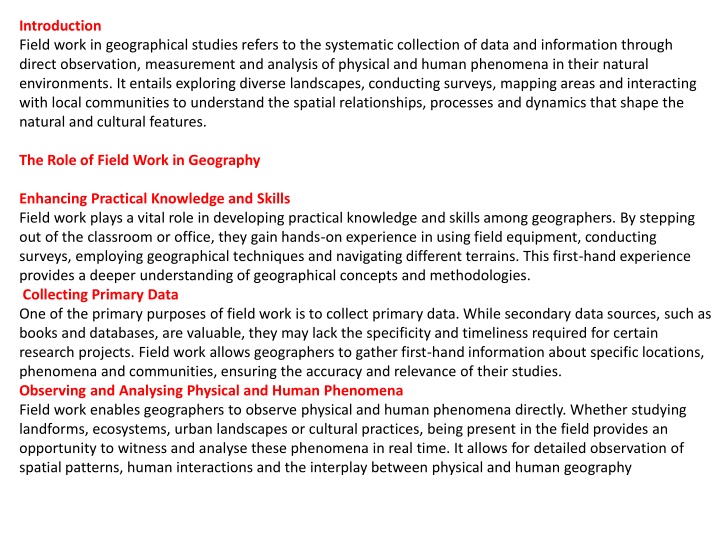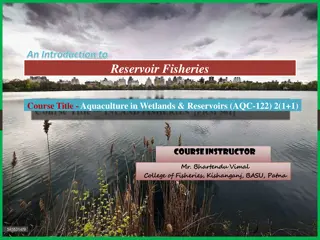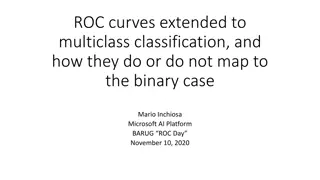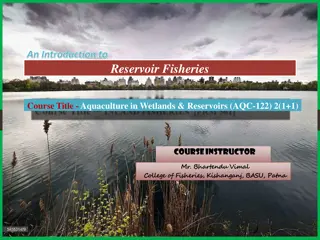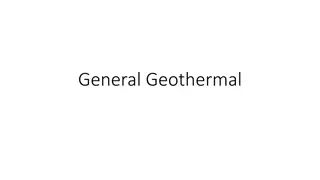Functions and Classification of Reservoirs
Reservoirs play a crucial role in serving purposes like irrigation, water supply, hydroelectric power generation, flood control, navigation, recreation, and more. They are classified into storage, flood control, retarding, detention, distribution, multipurpose, and balancing reservoirs based on their functionalities and purposes. Each type serves a specific function in water management and resource utilization.
Download Presentation

Please find below an Image/Link to download the presentation.
The content on the website is provided AS IS for your information and personal use only. It may not be sold, licensed, or shared on other websites without obtaining consent from the author.If you encounter any issues during the download, it is possible that the publisher has removed the file from their server.
You are allowed to download the files provided on this website for personal or commercial use, subject to the condition that they are used lawfully. All files are the property of their respective owners.
The content on the website is provided AS IS for your information and personal use only. It may not be sold, licensed, or shared on other websites without obtaining consent from the author.
E N D
Presentation Transcript
Introduction Field work in geographical studies refers to the systematic collection of data and information through direct observation, measurement and analysis of physical and human phenomena in their natural environments. It entails exploring diverse landscapes, conducting surveys, mapping areas and interacting with local communities to understand the spatial relationships, processes and dynamics that shape the natural and cultural features. The Role of Field Work in Geography Enhancing Practical Knowledge and Skills Field work plays a vital role in developing practical knowledge and skills among geographers. By stepping out of the classroom or office, they gain hands-on experience in using field equipment, conducting surveys, employing geographical techniques and navigating different terrains. This first-hand experience provides a deeper understanding of geographical concepts and methodologies. Collecting Primary Data One of the primary purposes of field work is to collect primary data. While secondary data sources, such as books and databases, are valuable, they may lack the specificity and timeliness required for certain research projects. Field work allows geographers to gather first-hand information about specific locations, phenomena and communities, ensuring the accuracy and relevance of their studies. Observing and Analysing Physical and Human Phenomena Field work enables geographers to observe physical and human phenomena directly. Whether studying landforms, ecosystems, urban landscapes or cultural practices, being present in the field provides an opportunity to witness and analyse these phenomena in real time. It allows for detailed observation of spatial patterns, human interactions and the interplay between physical and human geography
The Value of Field Work in Geography . Understanding Spatial Patterns and Relationships Field work offers a unique perspective on spatial patterns and relationships. By immersing themselves in different environments, geographers can better understand the interconnections between landforms, climate, vegetation and human activities. This understanding is crucial for spatial analysis, regional planning and the development of sustainable solutions to geographical challenges. Enriching Research and Academic Studies Field work significantly enriches research and academic studies in geography. It adds depth and authenticity to scholarly work by providing first-hand data and insights. Researchers can incorporate field observations, measurements and interviews into their studies, resulting in more comprehensive and nuanced findings. Field work also allows researchers to identify gaps in existing knowledge, propose new hypot heses and contribute to the advancement of geographical theories and concepts. The Ethics of Field Work in Geography Field work in geography is not only about data collection and analysis but also about upholding ethical considerations. Geographers must be aware of and adhere to ethical guidelines to ensure the responsible and respectful conduct of their research.
Selection of study area and objectives Area-specific study Problem specific study Objectives- Major objectives of the field study are - Field requires investigation from different angles which is related to literature and practical experience. To study the natural or physical objects like topography, drainage, climate, soil and natural vegetation. To find out the economic, social and cultural realities of the region. All the studies are based on empirical evidence. To illustrate the relationship between natural and socio-cultural environment . Finally, field study is directed towards the solution of problem. Methods and techniques of field work Generally, Field study is divided into three stages--- Pre-field work, Field work and Post field work Pre-field work Before reaching the study area it is essential for a surveyor to collect the preliminary knowledge regarding the concerned area. So it is important to collect data about the area already published either in various books, journals, magazines even newspapers. Because subsequently in case of descriptive analysis the writings prove themselves as conductive to the data. In this stage necessary maps and other secondary data are collected. Such kind of maps are Topographical map, District Planning Series maps, city maps, soil map, geological map and other thematic maps. These maps are available in Survey of India, National Atlas and Thematic Mapping organization (NATMO), Geological Survey of India (GSI) other government organizations. Another important part of this stage is to prepare necessary questionnaire and schedule for collecting primary data.
Framing of questionnaire-schedule The term questionnaire was first coined by Sir Francis Galton. Questionnaire- schedule is a set of questions arranged in a systematic manner. Questionnaire survey is a popular method to investigat questioe socio-economic condition of an area. Difference betweennnaire and schedule Research schedule are being filled by the enumerators who are specially appointed for these purpose. On the contrary, questionnaire in technical term is the set of questions which is mailed to the respondents, respondents will send the filled questionnaire. Types of questions A good questionnaire or schedule consist of different types of questions like contingency question, matrix question, leading question, Likert question, dichotomous question, bipolar question, rating scale question, buying propensity question, open ended and double or multiple option type question. Sample and sampling All the items under consideration in any field on inquiry constitute a universe of population . A complete enumeration of all the items in the population is known as a census inquiry. A surveyor selects only a few items from the universe for our study purpose. The items so selected constitute what is technically called a sample. On the other hand, sampling is a method of collecting sample. Sampling techniques may be broadly classified as non-probability and probability
Field work Some common techniques for collecting primary data are observation, transect walk, interview, focused group, audio-visual media etc . According to purpose it may be of two types survey on physical objects and socio-economic aspects. A student or researcher of physical geography is mainly interested in topography, terrain and slope character, character of river or drainage, physical and chemical properties of soil and nature of vegetation etc. During the survey a researcher should carry the useful instruments like Prismatic Compass, Dumpy or Auto Level, Transit Theodolite, Abney Level, Clinometer, Laser Distance Meter, Geological hammer, shovel, ground pin, tape, measuring staff, soil sampler, sediment sampler and current meter, chain etc. Recently Global Positioning System (GPS) becomes popular for ground survey. Except these, board, clip, field book, paper, tracing paper, pen, pencil and eraser are also must give place in the checklist of vital equipment. Ground survey or topographical survey involves determining the horizontal and vertical posion of objects on earth surface. Ground survey may be done by either traversing method or triangulation method. In the method of traversing the whole area is enclosed by closed traversing . The magnetic bearing of each line is measured by prismatic compass. Sometimes open traversing may be useful for making alignment for a road or a narrow channel. Besides Dumpy or Auto level is used for levelling and contouring i.e. vertical position or altitude of different stations. Apart from topography a researcher can be interested in studying river or drainage pattern. For knowing their changing course or problem of sedimentation depth and velocity should be measured. Collection of soil sample is important for knowing its physical and chemical properties like texture, soil PH.
Post Field Work The steps to be followed in this stage are--- Tabulation Statistical table is a systematic arrangement of quantitative data under appropriate heads in rows and columns. Thus, tabulation may be defined as the logical and systematic organization of statistical data. Raw data should be tabulated so that the whole information can be viewed at a glance. The advantages of tabulation are---- Tabulation enables the significance of data reading understood and leaves a lasting impression than textual presentation. It facilitates quick comparison to statistical data shown between row and columns. Representation of explanatory terms and phrases can be avoided, and the concise tabular form clearly reveals the characteristics of data. Representation of data There are many methods and techniques of representation of data. Some of these are mapping, graphical representation, diagram and cartograms and descriptive analysis. Mapping A map is a symbolic representation of selected characteristics of a place, usually drawn on a flat surface. Maps present information about the world in a simple, visual way. They teach about the world by showing sizes and shapes of countries, locations of features, and distances between places (Source: National Geographic Society) Many thematic maps are now made with the help of geographic information system (GIS) technology. GIS are computer systems that capture, store, and display data related to positions on Earth s surface. This technology combines information from maps with other data about people, the landscape, climate, soil, land use and land cover and much more, allowing multiple sets of data to be displayed on a single map.
Different types of socio-economic data can be represented graphically or with the help of cartograms. Some popular graphical techniques are Line graph, Climograph, Normal rainfalltemperature graph, Relative Temperature graph, Hythergraph, Stargraph, Hypsometric curve, Ergograph and many more. Apart from this there are many cartograms like different types Bar diagram, Pyramidal diagram, Pie diagram, Square diagram, Triangle diagram, Ternary graph, Flow diagram etc. Descriptive analysis After preparing maps and diagrams on the basis primary and secondary data a surveyor starts to a field report. Obviously it should be based on objectives of field work and the nature and range of collected information. Before writing report a draft of chapter contents should be kept ready. A student of geography (not researcher) can prepare a field report under the following the following chapters. The first chapter is always an introductory chapter which contains a) definition and purpose of field study b) methods of field work c) selection of the study area d) database and methodology adopted in present field work e) limitation of field study The subject matter of the second chapter is the physical account of this locality and its adjacent area. The topics covered in this chapter are a) location of the study area b) historical background (if any) c) geology physiography d) climate e) soil and vegetation. The descriptions must be factual and informative but not so lengthy. It is better to incorporate necessary maps, diagrams and images properly within the theoretical description. Third chapter is mostly related to the socio-economic and cultural realities. The subthemes of this section are a) a brief note on study area b) general land use and land cover c) Demography (i.e. sex ratio, age- group, family size, caste, religion, language etc.) d) Education e) Occupation, income and expenditure, standard of living f) Transport and communication g) Market and other establishment g) Tourism. The concluding chapter must be analytical. Here physical and socio-economic issues or problems are taken into account. Impact of human activities on environment as well as environmental impact on human society --- is a vital part of discussion. Students can include some own view in this regard. Lastly annexure and bibliography must be added at the end of the report.
